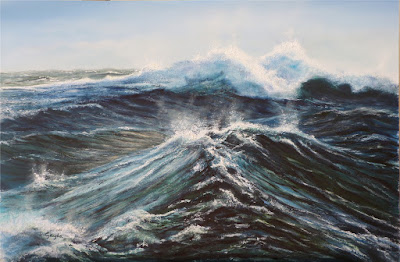Thou Swell
Waves wave. Swells
swell. Oceans are never still, always
moving. Shaking out a bedsheet explains
it all.
 I am loving the book “How to Read Water: Clues and Patterns
from Puddles to the Sea” by Tristan Gooley, a quirky British explorer and
navigator.
I am loving the book “How to Read Water: Clues and Patterns
from Puddles to the Sea” by Tristan Gooley, a quirky British explorer and
navigator.
Here is how he explains that a wave is actually not water in
motion. A wave is energy moving through
the water. Like the bedsheet.
“There are three types of waves – ripples, waves, and swell. Swell is best thought of as waves that have
enough energy to travel well beyond the place of their origin. Ripples will struggle to reach the far side
of a pond if the wind dies away, waves will only travel a few miles without a
supporting wind, but swell will cross great oceans – thousands of miles is
common.”
“All water waves – ripples, waves and swell, take energy
from one place to another. In the oceans
there are only three main sources of wave energy: the moon, earthquakes and the
wind. The most common is the wind – it
passes over the water, imparts some of its energy to the water, this energy
moves in a direction, and this is visible as a wave.”
“This idea of waves taking energy from one place to another
is important, because it is very tempting to think of waves as the water moving
horizontally, but that isn’t what is happening.
“Think of shaking out a bedsheet. The shaking makes a visible wave that takes
lots of energy from one end to another as it travels. The force that is giving it the energy, in
this case, one pairs of hands, moves it to another place, in this case a
whipping sound at the other end of the sheet.
But, the sheet itself hasn’t move horizontally, only up and down.
“Watch any waves out at sea and your eyes will tend to
follow an individual wave as it travels, giving the impression that the water
is moving with it. But focus on anything
floating on the surface, like seaweed, a piece of wood, or a bird, and you will
see how they stay in the same place, as the wave’s energy moves them up and
down, but not along.”
Wave, shaken sheet, even Holy Spirit – we picture these as individual
things, but they are really energy moving through things. We know this when we use “wavy words” to
describe the energy of fullness and passion.
“My heart swells with love.” “I
am feeling waves of emotion.” “A ripple of excitement ran through the
crowd.” Moving energy, filling up,
spilling over.
“Fountain fullness.”
Those are the “wavy words” that St. Bonaventure, Franciscan mystic and
theologian, uses to describe God.
We all can float In this wavy fountain fullness, trusting
God’s wet and wonderful energy to move in and through us. Thou swell.
_______
“Keep Tahoe Blue” is a popular bumper sticker. Our Blue Theology Mission Station tries to
“Keep God Blue” by helping people of faith connect with ocean stewardship and
spiritualty. Take part in our youth and adult mission trips and retreats, read
and share these Wednesday “Blue Theology Tide-ings,” and come to our newest
project, a May 9 Blue Theology Retreat and Resource Day for Clergy and
Religious Educators in Pacific Grove.
Bluetheology.com
“Ocean Swell” painting by David Gayda.

